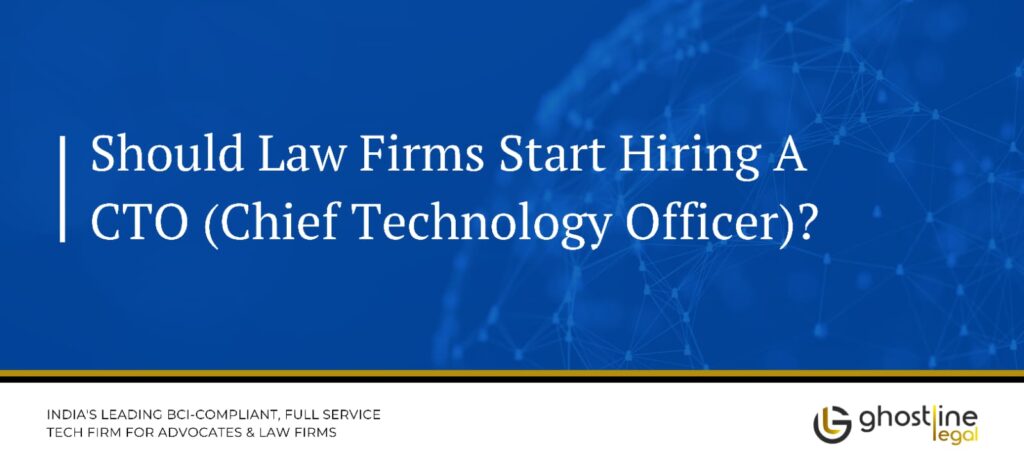Who is a Chief Technology Officer?
A Chief Technology Officer (CTO) refers to the highest individual executive position in a company that is responsible for overseeing the long-term technical strategy of an organisation. Unlike other positions, like a CTO normally concerned only with the IT systems of the organisation, the CTO has responsibilities that envelop the whole technological environment of the organisation. This is to lead in designing and embracing innovative technologies that will foster the growth of the organisation.
Roles and responsibilities of Chief Technology Officer in a Law Firm
- Blending Technology and Strategy- One of the most important roles that a CTO in a law firm does is ensure the concurrence of technology with the strategic objectives of the firm. Unlike the Chief Information Officer, whose major role is management and maintenance of the internal IT infrastructure, the Chief Technical Officer is a forward-looking executive tasked with promotion of innovation and how best a law firm can be competitive in a changing legal environment.
- Emerging Technologies Integration- Chief Technology Officer brings emerging technologies into play in a law firm. The primary concern of the Chief Technical Officer is the incorporation of legal technology execution, sometimes referred to as ‘legal tech.’ This means using technology and software to optimise and enhance legal procedures, encompassing document automation and e-discovery tools, AI-powered legal research systems, and contract management systems.
The CTO finds and implements those technologies that make the legal company function more effectively, with reduced manual duties and improved accuracy. This, in turn, not only saves time and reduces expenses incurred but also enables quality services to the client. Legal technology empowers the firm to manage larger workloads efficiently with enhanced accuracy so that lawyers’ attention can be channelled to more intricate and strategic assignments.
- Data Protection and Privacy- CTO in a law firm plays a vital role in protecting data and its privacy. Since legal activity is compassionate, law firms handle vast volumes of sensitive information for clients; therefore, appropriate measures to safeguard that data are called for. It falls within the remit of the CTO to implement and monitor the company’s cybersecurity strategy, ensuring that customers’ data is well protected from penetration, unauthorised access, and other security threats. This will involve advanced data encryption techniques, secure cloud storage solutions, and regular security audits for possible vulnerability detection and the implementation of a solution.
How to hire a Chief Technology Officer for your law firm?
- The first step in recruiting a CTO for a law firm will be to distinctly define his role and responsibilities. This includes the development of technology strategies, supervision of the integration of technology, and promotion of innovation. Equally important will be defining what type of qualification and experience is needed for this position. These include understanding the firm’s business objectives and experience with legal technology.
- Next, assess what the current technology infrastructure lacks in the organisation and set a budget that includes any investment in technology as well as the prospective salary but also makes sure it is commensurate with the strategic importance of the position.
- Utilise niche employment boards, executive search firms, and professional networks to begin a focused recruitment effort that will help secure qualified candidates.
- Conduct all-round screening. Emphasise the ability to align technology with the business goals and give past examples of innovation. Screen technical skills, leadership ability, and cultural fit in the interview process with the use of situational and behavioural questions.
- Engage the important stakeholders to ensure that the firm’s needs and values are aligned.
- If a candidate is selected, the onboarding process should be all-rounded to guarantee effective integration and impact.
- It needs to establish a framework for continued communication and performance evaluation, set out clear expectations and objectives for the first period, and assure that effective integration into the operations and culture of the firm takes place
Challenges in hiring a Chief Technology Officer for your law firm
- Technical Debt Management- Probably one of the biggest challenges when hiring a CTO is inheriting technical debt. Any law firm may have collected some outdated technologies or unsolved technical problems over the years. Apart from purely technical competence to resolve these issues, a strategic approach to modernization of the legacy systems without interference with the critical business processes is required.
- Management of Legacy Applications- The challenge lies in those legacy applications that mean so much to the business but are very difficult to upgrade. The CTO needs to manage the complexity of keeping such systems going, while progressively introducing new technologies in step with the developing needs of the firm.
- Addressing the Deficits of Skills-If the crew skills are less than adequate, it will hinder the implementation of new technologies. That is why the CTO needs to constantly bench-mark the capability of the current team against the required needs and fill up the deficiencies in skills through training, hiring, or collaborating to bring the team in alignment with the technological requirements of the firm.
Case Studies: Leading Firms with Chief Technology Officer
International firms
- Clifford Chance
Global leader of legal services Clifford Chance has invested in technology at the core of its operations with a Chief Technology Officer. The organisation has set up Clifford Chance Applied Solutions to drive innovation and bring leading-edge technologies like blockchain and artificial intelligence to life. This strategic step will create a benchmark for incorporating technology into the legal industry through enhanced efficiency in operations, supporting complex legal research, and sophisticated client solutions.
- Dentons
One of the largest law firms in the world, Dentons, now adoptes technology and opens an independent innovation unit. Nextlaw Labs will, therefore, be managed by its Chief Technology Officer in charge of developing innovative legal technology solutions and promulgation of startup collaborations. This move will not only enhance the deliverance of legal services but also demonstrate the commitment of the firm to maintaining leadership in technological advancement.
Indian Firms
- Cyril Amarchand Mangaldas
Large Indian law firm Cyril Amarchand Mangaldas has appointed a Chief Technical Officer in its recognition of the role of technology. The new CTO is empowered with administering the digital transformation processes within the organisation, including AI-driven legal research tools and document management systems. This focus on technology helps the law firm to be at an advantage in comparison to others in the legal market of India, giving it leverage and efficiency.
- Shardul Amarchand Mangaldas
Shardul Amarchand Mangaldas has adopted another visionary approach in bringing a Chief Technology Officer to lead its technology vision. The institution’s CTO has been dedicated to the adoption of state-of-the-art technologies in the quest to streamline internal operations and set the highest standards in service delivery toward clients. Here it may be identified that this move set a statement regarding the commitment of the institution toward capturing the power of technology to bring more efficiency into its operation and in the practice of law.
Conclusion
Modern law firms should engage a chief technical officer in the pursuit of innovativeness and competitiveness. The Chief Technology Officer can enhance client services, optimise operations, and increase technological innovation. Accordingly, investing in the position, defining the CTO’s role, and determining technology needs can help firms to maximise on the position. By doing so, law firms are able to successfully navigate the ongoing digital transformation and secure a strategic advantage within the evolving legal environment.
Bibliography
- Paul D. McGreal, Hiring a Chief Technology Officer: What Law Firms Need to Know, 78 ALB. L. REV. 135 (2014).
- Daniel S. Mungai, Aligning Technology Strategy with Business Goals, 45 TECH. & L. J. 78 (2020).
- Angle, Ankura, When Do You Need a Chief Technology Officer (CTO)?, April 26, 2023, https://angle.ankura.com/post/102idj6/when-do-you-need-a-chief-technology-officer-cto.
Ghostline Legal is India’s first full-service BCI-compliant tech firm for litigation chambers and law firms. Check our services HERE.








